Coupling Coordination and Influencing Factors Between Digital Village Development and Agricultural and Rural Modernization: Evidence from China
Abstract
1. Introduction
2. Literature Review
2.1. Digital Village
2.2. Agricultural and Rural Modernization
2.3. Digital Villages and Agricultural and Rural Modernization
2.4. Research Space
3. Coupling Analysis Between Digital Villages and Agricultural and Rural Modernization
4. Research Design
4.1. Construction of the Indicator System
4.2. Research Methods
4.2.1. Entropy Weight-TOPSIS Method
4.2.2. Coupling Coordination Model
4.2.3. Geographical Detector
4.3. Data Sources
5. Results of the Analysis
5.1. Evaluation of Digital Villages and Agricultural and Rural Modernization
5.2. Analysis of Coupling Coordination Development of Digital Villages and Agricultural and Rural Modernization
5.3. Analysis of the Driving Mechanism of the Spatiotemporal Differentiation of Coupling Coordination
5.3.1. Influencing Factors
5.3.2. Single-Factor Detection Analysis
5.3.3. Factor Interaction Detection Analysis
5.3.4. Driving Mechanism Analysis
6. Conclusions and Discussion
6.1. Conclusions
6.2. Contribution to Theory
6.3. Contribution to Practice
6.4. Recommendations
6.5. Limitations and Future Work
Author Contributions
Funding
Institutional Review Board Statement
Data Availability Statement
Conflicts of Interest
References
- Yan, Z.; Peng, L.; Wu, X. Evaluation System for Agricultural and Rural Modernization in China. Agriculture 2023, 13, 1930. [Google Scholar] [CrossRef]
- Knickel, K.; Redman, M.; Darnhofer, I.; Ashkenazy, A.; Calvão Chebach, T.; Šūmane, S. Between Aspirations and Reality: Making Farming, Food Systems and Rural Areas More Resilient, Sustainable and Equitable. J. Rural Stud. 2018, 59, 197–210. [Google Scholar] [CrossRef]
- Janvry, A.; Sadoulet, E. Using Agriculture for Development: Supply- and Demand-Side Approaches. World Dev. 2020, 133, 105003. [Google Scholar] [CrossRef]
- Liu, M.; Fang, X.; Ren, J. Accelerating the Modernization of Agriculture and Rural Areas in China. China Agric. Econ. 2023, 15, 871–880. [Google Scholar] [CrossRef]
- Rijswijk, K.; Klerkx, L.; Bacco, M.; Bartolini, F.; Kolodziejczyk, B.; Brunori, G. Digital Transformation of Agriculture and Rural Areas: A Socio-Cyber-Physical System Framework to Support Responsibilisation. J. Rural Stud. 2021, 85, 79–90. [Google Scholar] [CrossRef]
- Zhao, W.; Liang, Z.; Li, B. Realizing a Rural Sustainable Development through a Digital Village Construction: Experiences from China. Sustainability 2022, 14, 14199. [Google Scholar] [CrossRef]
- Zhao, Y.; Li, R. Coupling and Coordination Analysis of Digital Rural Construction from the Perspective of Rural Revitalization: A Case Study from Zhejiang Province of China. Sustainability 2022, 14, 3638. [Google Scholar] [CrossRef]
- Sutriadi, R. Defining Smart City, Smart Region, Smart Village, and Technopolis as an Innovative Concept in Indonesia’s Urban and Regional Development Themes to Reach Sustainability. IOP Conf. Ser. Earth Environ. Sci. 2018, 202, 012047. [Google Scholar] [CrossRef]
- Petr, H.; Kopacek, M.; Krawczyk, A.; Grepl, M. Barriers for and Standpoints of Key Actors in the Implementation of Smart Village Projects as a Tool for the Development of Rural Areas. J. Rural Stud. 2023, 103, 103098. [Google Scholar]
- Scuderi, A.; La Via, G.; D’Amico, M. The Digital Applications of “Agriculture 4.0”: Strategic Opportunity for the Development of the Italian Citrus Chain. Agriculture 2022, 12, 400. [Google Scholar] [CrossRef]
- Leong, C.; Pan, S.L.; Newell, S.; Cui, L. The Emergence of Self-Organizing E-Commerce Ecosystems in Remote Villages of China: A Tale of Digital Empowerment for Rural Development. MIS Q. 2016, 40, 475–484. [Google Scholar] [CrossRef]
- Liu, Y.; Liu, C.Y.; Zhou, M. Does Digital Inclusive Finance Promote Agricultural Production for Rural Households in China? Research Based on the Chinese Family Database (CFD). China Agric. Econ. Rev. 2021, 13, 475–494. [Google Scholar] [CrossRef]
- Leng, X. Digital Revolution and Rural Family Income: Evidence from China. J. Rural Stud. 2022, 94, 336–343. [Google Scholar] [CrossRef]
- Pylianidis, C.; Osinga, S.; Athanasiadis, I.N. Introducing Digital Twins to Agriculture. Comput. Electron. Agric. 2021, 184, 105942. [Google Scholar] [CrossRef]
- Klerkx, L.; Jakku, E.; Labarthe, P. A Review of Social Science on Digital Agriculture, Smart Farming, and Agriculture 4.0: New Contributions and a Future Research Agenda. NJAS Wagening. J. Life Sci. 2022, 90, 100315. [Google Scholar] [CrossRef]
- Cao, X.; Yan, M.; Wen, J. Exploring the Level and Influencing Factors of Digital Village Development in China: Insights and Recommendations. Sustainability 2023, 15, 10423. [Google Scholar] [CrossRef]
- Liu, Z.; Gao, P.; Li, W. Research on Big Data-Driven Rural Revitalization Sharing Co-Governance Mechanism Based on Cloud Computing Technology. Wirel. Commun. Mob. Comput. 2022, 2022, 2163126. [Google Scholar]
- Mei, Y.; Miao, J.; Lu, Y. Digital Villages Construction Accelerates High-Quality Economic Development in Rural China through Promoting Digital Entrepreneurship. Sustainability 2022, 14, 14224. [Google Scholar] [CrossRef]
- Liu, S.; Zhu, S.; Hou, Z.; Peng, Z.; Wang, X. Digital Village Construction, Human Capital, and the Development of the Rural Older Adult Care Service Industry. Front. Public Health 2023, 11, 1190757. [Google Scholar] [CrossRef]
- Lu, Y.; Xie, Q.; Zhang, Z. Digital Village Construction: Right Research on the Impact of Digital Literacy among Rural Residents. Highlights Bus. Econ. Manag. 2024, 34, 15–21. [Google Scholar] [CrossRef]
- Liu, B.; Zhou, J. Digital Literacy, Farmers’ Income Increase, and Rural Internal Income Gap. Sustainability 2023, 15, 11422. [Google Scholar] [CrossRef]
- Radovanović, D.; Holst, C.; Belur, S.B.; Castillo, G. Digital Literacy Key Performance Indicators for Sustainable Development. Soc. Incl. 2020, 8, 151–167. [Google Scholar] [CrossRef]
- Abiddin, N.Z.; Ibrahim, I.; Aziz, S.A.A. Advocating Digital Literacy: Community-Based Strategies and Approaches. Acad. J. Interdiscip. Stud. 2022, 11, 198. [Google Scholar] [CrossRef]
- Malik, P.K.; Singh, R.; Gehlot, A.; Pandey, V. Village 4.0: Digitalization of Village with Smart Internet of Things Technologies. Comput. Ind. Eng. 2022, 165, 107938. [Google Scholar] [CrossRef]
- Engas, K.G.; Raja, J.Z.; Neufang, I.F. Decoding Technological Frames: An Exploratory Study of Access to and Meaningful Engagement with Digital Technologies in Agriculture. Technol. Forecast. Soc. Change 2023, 190, 122405. [Google Scholar] [CrossRef]
- Wang, H.; Tang, Y. Spatiotemporal Distribution and Influencing Factors of Coupling Coordination between Digital Village and Green and High-Quality Agricultural Development—Evidence from China. Sustainability 2023, 15, 8079. [Google Scholar] [CrossRef]
- Wang, P.; Li, C.; Huang, C. The Impact of Digital Village Construction on County-Level Economic Growth and Its Driving Mechanisms: Evidence from China. Agriculture 2023, 13, 1917. [Google Scholar] [CrossRef]
- Rivera, M.; Knickel, K.; Ríos, I.D.L.; Ashkenazy, A.; Chebach, T.C.; Šūmane, S. Rethinking the Connections between Agricultural Change and Rural Prosperity: A Discussion of Insights Derived from Case Studies in Seven Countries. J. Rural Stud. 2018, 59, 242–251. [Google Scholar] [CrossRef]
- Milone, P.; Ventura, F. New Generation Farmers: Rediscovering the Peasantry. J. Rural Stud. 2019, 65, 43–52. [Google Scholar] [CrossRef]
- Xia, M.; Zeng, D.; Huang, Q.; Zhu, W. Coupling Coordination and Spatiotemporal Dynamic Evolution between Agricultural Carbon Emissions and Agricultural Modernization in China 2010–2020. Agriculture 2022, 12, 1809. [Google Scholar] [CrossRef]
- European Commission. Smart Villages. Smart Villages Brief. Note. 2019. Available online: https://digitevent-images.s3.amazonaws.com/5c0e6%20198801d2065233ff996-registrationfiletexteditor-1551115459927-smart-villages-briefing-note.pdf (accessed on 22 October 2024).
- Hao, A.; Hou, Y.; Tan, J. How Does Digital Village Construction Influence Carbon Emission? The Case of China. PLoS ONE 2022, 17, e0278533. [Google Scholar] [CrossRef] [PubMed]
- Li, H.; Ma, Y.; Ren, J.; Wang, H.; Zhang, L. Spatiotemporal Dynamic Evolution and Influencing Factors of Family Farms in Urban Agglomerations in the Middle Reaches of the Yangtze River. Front. Environ. Sci. 2022, 10, 1001274. [Google Scholar] [CrossRef]
- Zhang, C.; Li, Y.; Yang, L.; Elahi, E.; Hou, L. Does the Development of Digital Inclusive Finance Promote the Construction of Digital Villages?—An Empirical Study Based on the Chinese Experience. Agriculture 2023, 13, 1616. [Google Scholar] [CrossRef]
- Rosário, A.T.; Dias, J.C. Sustainability and the Digital Transition: A Literature Review. Sustainability 2022, 14, 4072. [Google Scholar] [CrossRef]
- Liu, M.; Liu, H. The Influence and Mechanism of Digital Village Construction on the Urban–Rural Income Gap under the Goal of Common Prosperity. Agriculture 2024, 14, 775. [Google Scholar] [CrossRef]
- Zhang, L.; Ma, X. Analysis on the Path of Digital Villages Affecting Rural Residents’ Consumption Upgrade: Based on the Investigation and Research of 164 Administrative Villages in the Pilot Area of Digital Villages in Zhejiang Province. Comput. Intell. Neurosci. 2022, 2022, 9928030. [Google Scholar] [CrossRef]
- Chen, K.; Tian, G.; Tian, Z.; Wang, P. Evaluation of the Coupled and Coordinated Relationship between Agricultural Modernization and Regional Economic Development under the Rural Revitalization Strategy. Agronomy 2022, 12, 990. [Google Scholar] [CrossRef]
- Cai, Z.; Li, S.; Cheng, D. Has Digital Village Construction Improved Rural Family Resilience in China? Evidence Based on China Household Finance Survey. Sustainability 2023, 15, 8704. [Google Scholar] [CrossRef]
- Zhang, Z.; Li, Y.; Elahi, E.; Wang, Y. Comprehensive Evaluation of Agricultural Modernization Levels. Sustainability 2022, 14, 5069. [Google Scholar] [CrossRef]
- Yang, F. Impact of Agricultural Modernization on Agricultural Carbon Emissions in China: A Study Based on the Spatial Spillover Effect. Environ. Sci. Pollut. Res. 2023, 30, 91300. [Google Scholar] [CrossRef]
- Jiang, Q.; Li, J.; Si, H.; Su, Y. The Impact of the Digital Economy on Agricultural Green Development: Evidence from China. Agriculture 2022, 12, 1107. [Google Scholar] [CrossRef]
- Huttunen, S. Revisiting Agricultural Modernisation: Interconnected Farming Practices Driving Rural Development at the Farm Level. J. Rural Stud. 2019, 71, 36–45. [Google Scholar] [CrossRef]
- Fei, X.; Feng, J. Research on the High-Quality Development Model of China’s Grain Industry from the Perspective of Rural Revitalization. Wirel. Commun. Mob. Comput. 2022, 2022, 2661237. [Google Scholar] [CrossRef]
- Flynn, A.; Chan, K.W.; Zhu, Z.H.; Yu, L. Sustainability Space and Supply Chains: The Role of Bamboo in Anji County, China. J. Rural Stud. 2017, 49, 128–139. [Google Scholar] [CrossRef]
- Koopmans, M.E.; Rogge, E.; Mettepenningen, E.; Knickel, K.; Šūmane, S. The Role of Multi-Actor Governance in Aligning Farm Modernization and Sustainable Rural Development. J. Rural Stud. 2018, 59, 252–262. [Google Scholar] [CrossRef]
- Du, X.; Jiao, F. How the Rural Infrastructure Construction Drives Rural Economic Development through Rural Living Environment Governance—Case Study of 285 Cities in China. Front. Environ. Sci. 2023, 11, 1280744. [Google Scholar] [CrossRef]
- Manioudis, M.; Meramveliotakis, G. Broad strokes towards a grand theory in the analysis of sustainable development: A return to the classical political economy. New Political Econ. 2022, 27, 866–878. [Google Scholar] [CrossRef]
- Tomislav, K. The concept of sustainable development: From its beginning to the contemporary issues. Zagreb Int. Rev. Econ. Bus. 2018, 21, 67–94. [Google Scholar]
- Feroz, A.K.; Zo, H.; Chiravuri, A. Digital Transformation and Environmental Sustainability: A Review and Research Agenda. Sustainability 2021, 13, 1530. [Google Scholar] [CrossRef]
- Bielska, A.; Stańczuk-Gałwiaczek, M.; Sobolewska-Mikulska, K.; Mroczkowski, R. Implementation of the Smart Village Concept Based on Selected Spatial Patterns—A Case Study of Mazowieckie Voivodeship in Poland. Land Use Policy 2021, 104, 105366. [Google Scholar] [CrossRef]
- Qu, D.; Wang, X.; Kang, C.; Liu, Y. Promoting Agricultural and Rural Modernization through Application of Information and Communication Technologies in China. Int. J. Agric. Biol. Eng. 2018, 11, 1–4. [Google Scholar] [CrossRef]
- Ji, Y.; Wang, Y. Research on the Coupled Coordination of Digitization and the Modernization of Agriculture and Rural Areas. J. Agro-For. Econ. Manag. 2024. Available online: https://link.cnki.net/urlid/36.1328.F.20240725.1707.010 (accessed on 22 October 2024).
- Tian, Y.; Liu, Q.; Ye, Y.; Zhang, Z.; Khanal, R. How the Rural Digital Economy Drives Rural Industrial Revitalization—Case Study of China’s 30 Provinces. Sustainability 2023, 15, 6923. [Google Scholar] [CrossRef]
- Chen, X.; Xing, L.; Wang, K.; Lu, J. How Does Digital Governance Affect the Level of Domestic Waste Separation for Rural Residents? Empirical Evidence from Rural Areas in Jiangsu Province, China. Front. Public Health 2023, 11, 1122705. [Google Scholar] [CrossRef] [PubMed]
- Cheng, P.; Jin, Q.; Jiang, H.; Hua, M.; Ye, Z. Efficiency Assessment of Rural Domestic Sewage Treatment Facilities by a Slacked-Based DEA Model. J. Clean. Prod. 2020, 267, 122111. [Google Scholar] [CrossRef]
- Liu, J.N.; Wang, X.L.; Hou, Y.Z. The Impact of Village Cadres’ Public Service Motivation on the Effectiveness of Rural Living Environment Governance: An Empirical Study of 118 Chinese Villages. SAGE Open 2022, 12, 21582440221079795. [Google Scholar] [CrossRef]
- Wang, J.F.; Zhang, T.L.; Fu, B.J. A Measure of Spatial Stratified Heterogeneity. Ecol. Indic. 2016, 67, 250–256. [Google Scholar] [CrossRef]
- Wang, J.; Xu, C. Geodetector: Principle and Prospective. Acta Geogr. Sin. 2017, 72, 116–134. [Google Scholar] [CrossRef]
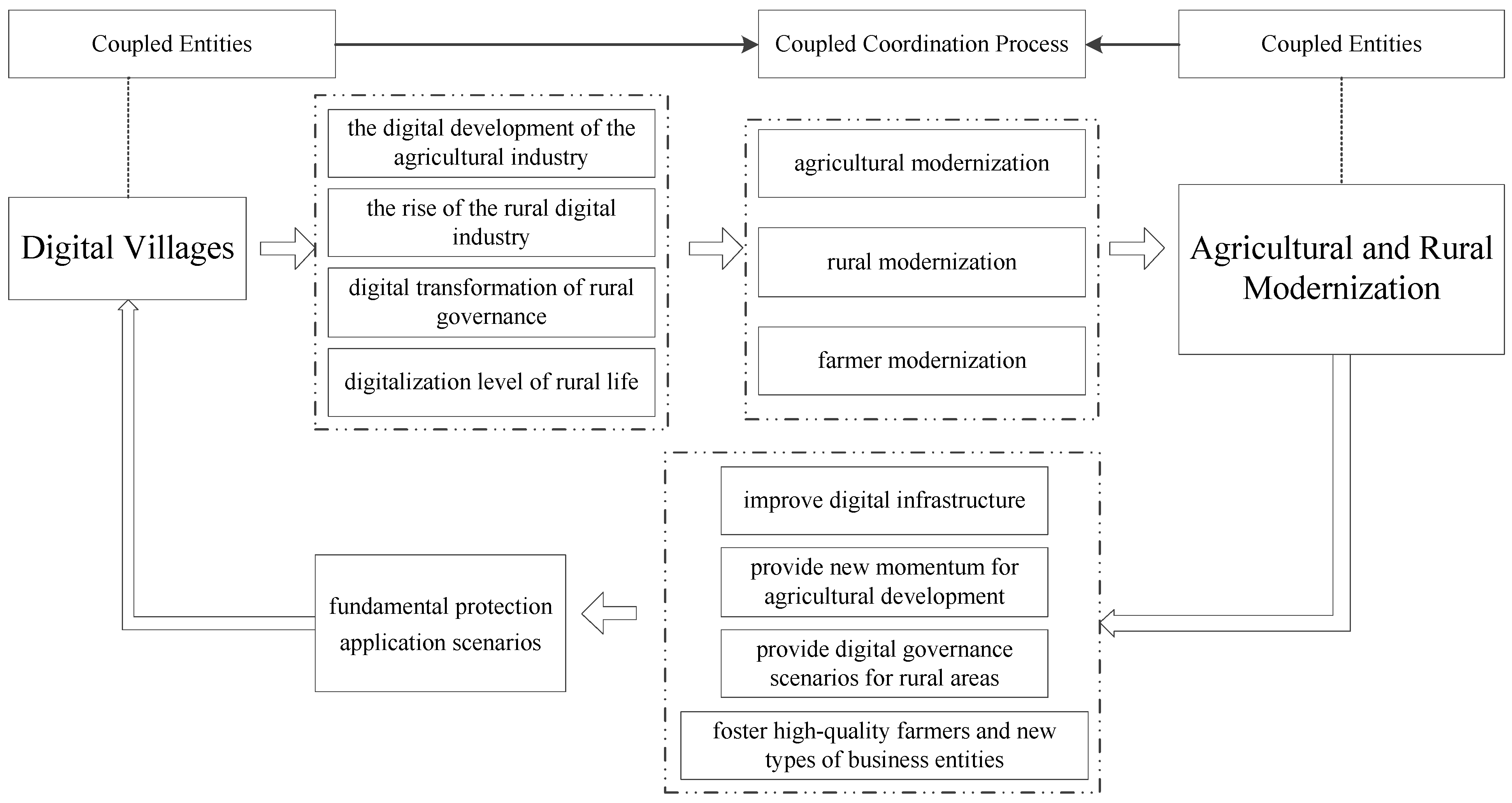
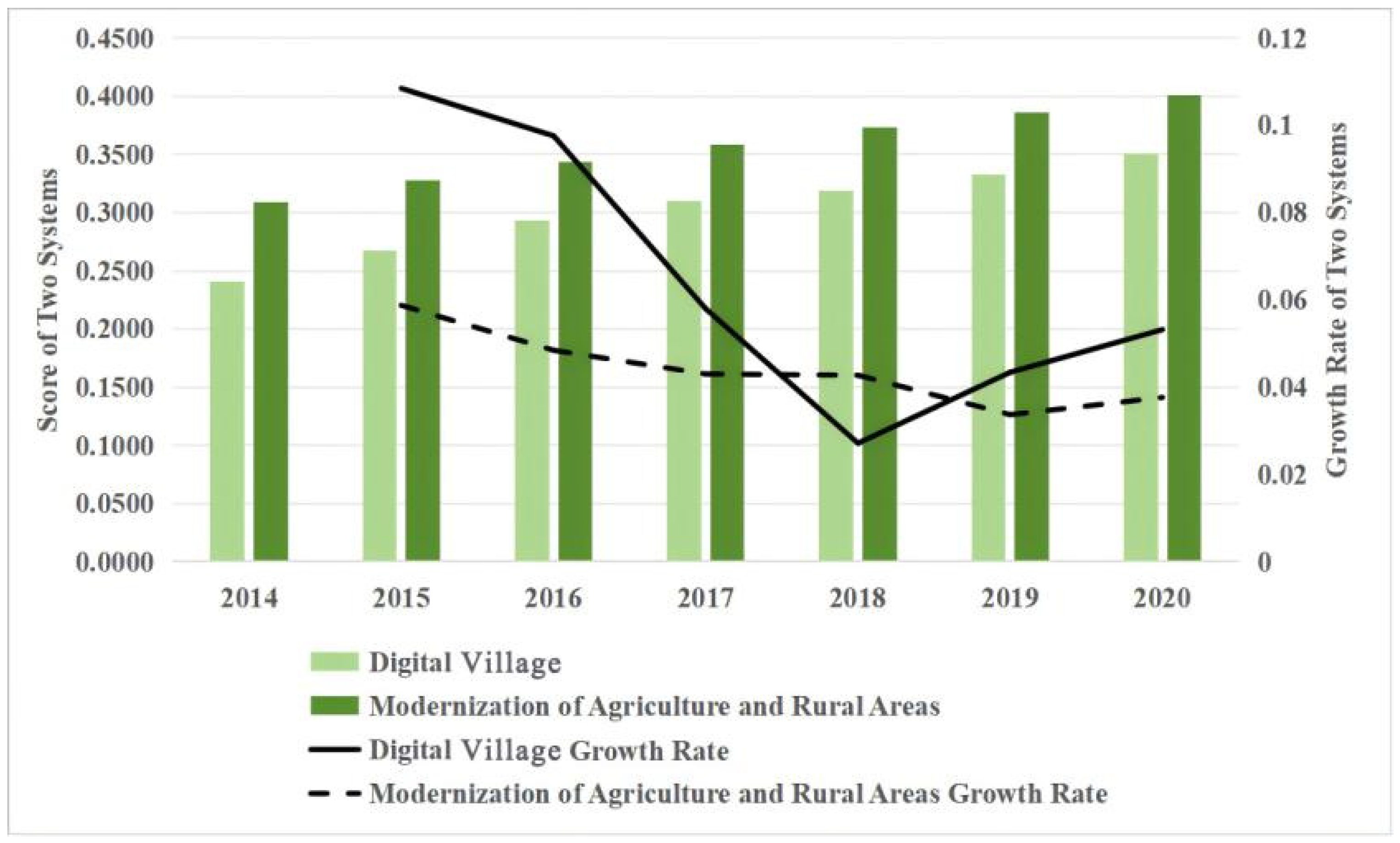

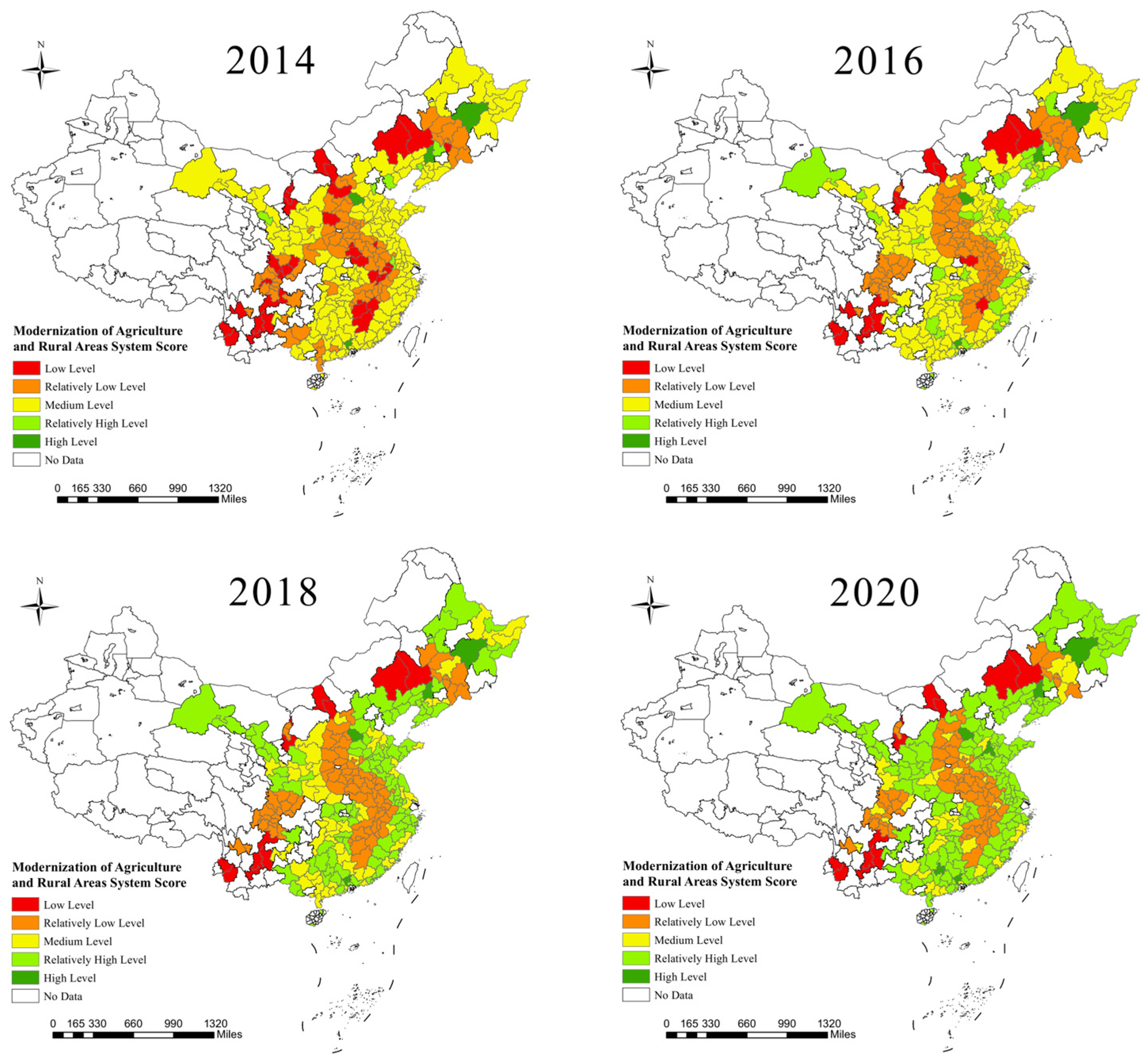
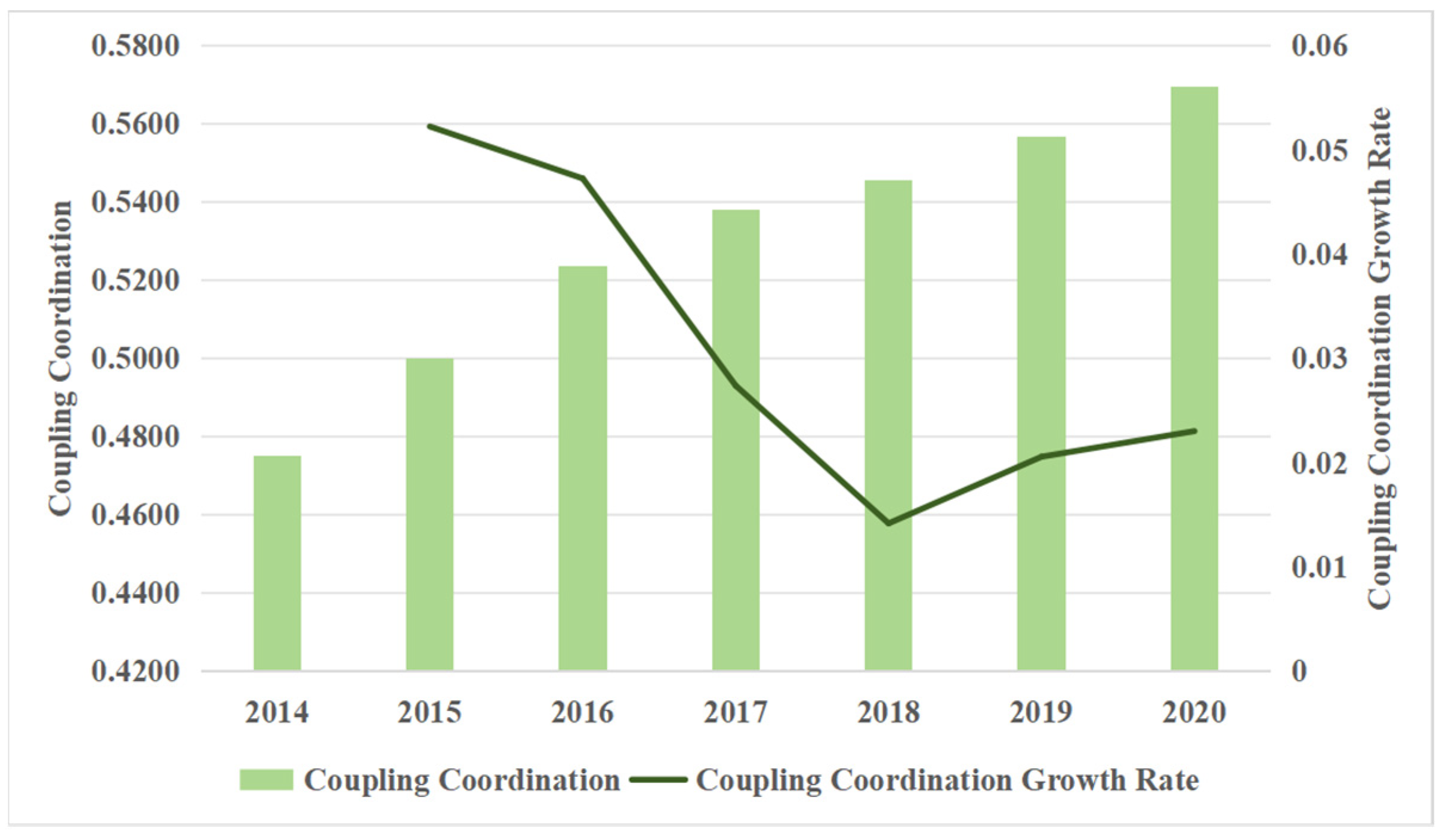
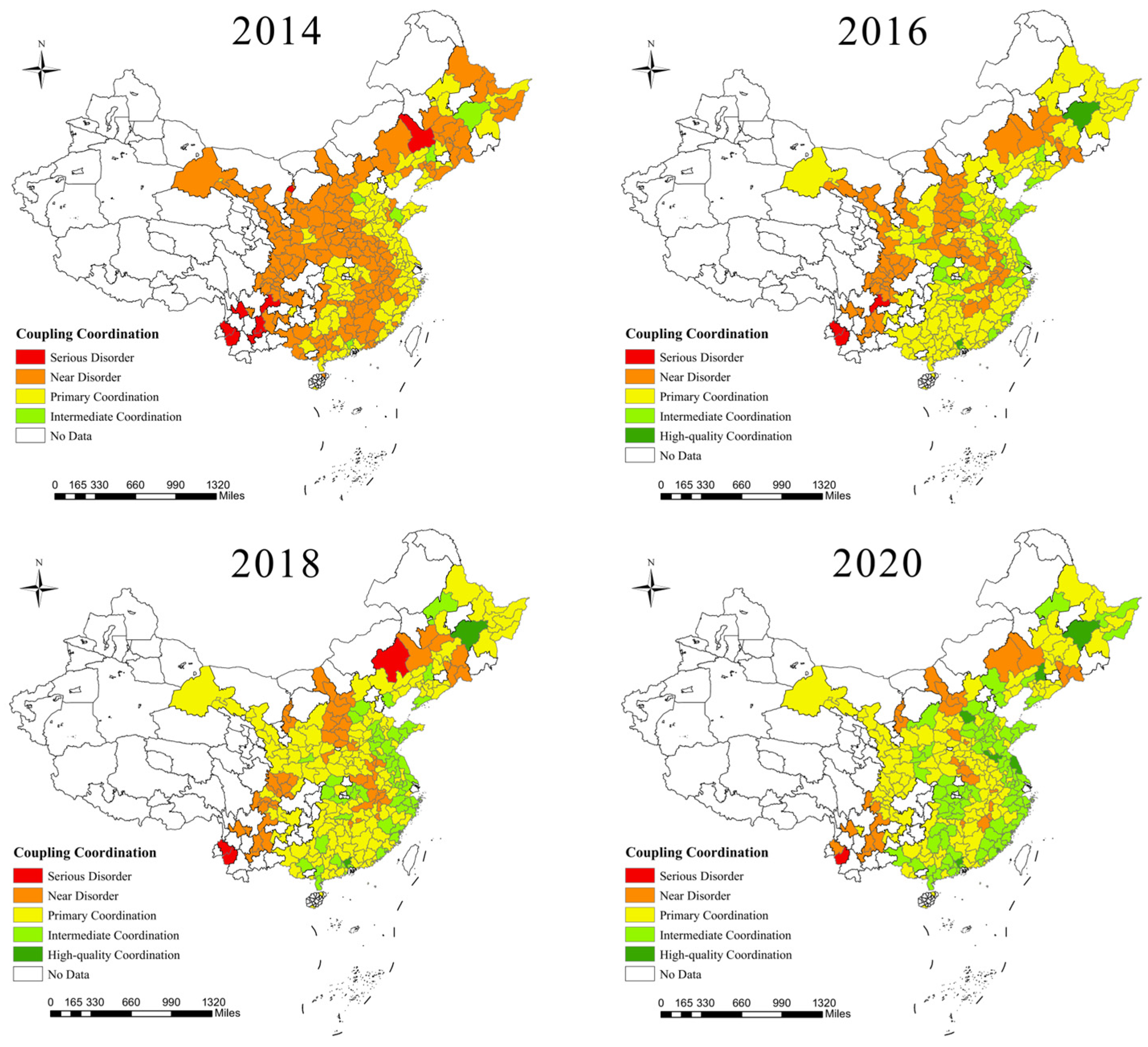
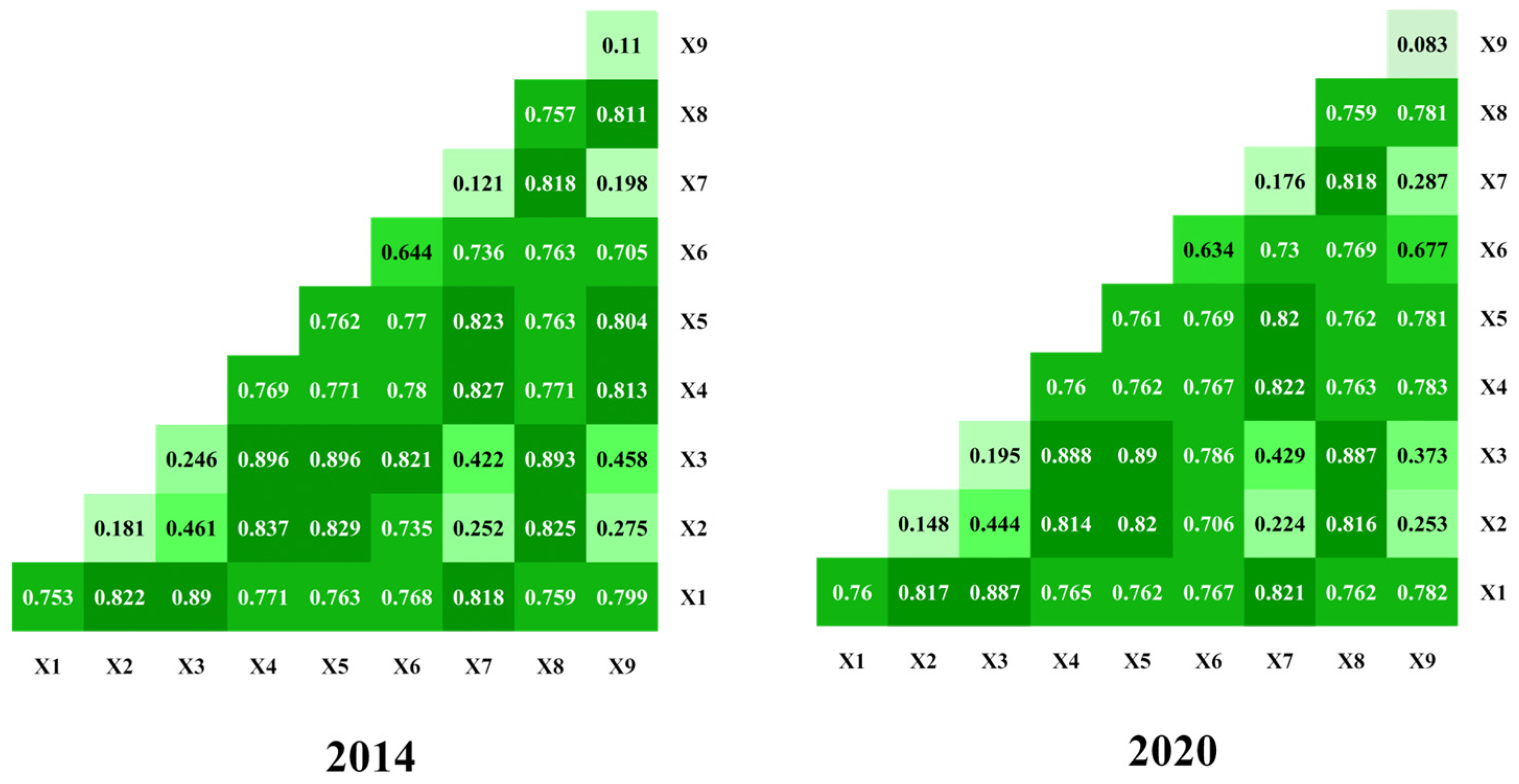
| Indicator | Type of Indicator | Content of Indicator |
|---|---|---|
| Digital Village | Digital Infrastructure | Percentage of Villages with Access to Internet Broadband Services Cable Television Coverage Rate Digital Infrastructure Index |
| Digitalization of Rural Life | Per Capita Disposable Income of Farmers Digital Financial Usage Level Number of Rural Cultural Centers | |
| Digitalization of Rural Industries | Proportion of Workforce in the Primary Industry Total Output Value of Agriculture, Forestry, Animal Husbandry, and Fisheries Digitalization Level of Inclusive Finance | |
| Level of Rural Governance | Proportion of Villages that Handle Household Waste Proportion of Villages that Treat Domestic Sewage Proportion of Village Heads and Party Secretaries Holding Both Positions |
| Indicator | Type of Indicator | Content of Indicator |
|---|---|---|
| Agricultural and Rural Modernization | Modernization of the Agricultural Industry System | Per Capita Vegetable Production Main Business Revenue of Agricultural Product Processing Enterprises Above Designated Size Comprehensive Grain Production Capacity |
| Modernization of the Agricultural Production System | Comprehensive Utilization Rate of Livestock and Poultry Manure Per Capita Total Agricultural Machinery Power Pesticide and Fertilizer Application Volume | |
| Modernization of the Agricultural Management System | Proportion of the Primary Industry in Regional GDP Agricultural Labor Productivity Inclusive Finance Composite Index | |
| Modernization of Rural Infrastructure and Public Services | Village Road Paving Rate Rural Green Coverage Rate Number of Health Technicians per 1000 Rural Residents Percentage of Full-Time Teachers with a Bachelor’s Degree or Higher in Rural Compulsory Education Schools | |
| Quality of Life for Rural Residents | Urban–Rural Income Ratio Engel’s Coefficient for Rural Residents Percentage of Rural Residents’ Expenditure on Education, Culture, and Recreation Average Years of Schooling of Rural Residents | |
| Modernization of Rural Governance Systems and Capacities | Urbanization rate Incidence of Rural Poverty Percentage of Administrative Villages that have Prepared Village Plans Percentage of Administrative Villages that have Carried out Village Improvement |
| Coupling Coordination Level | 2014 | 2015 | 2016 | 2017 | 2018 | 2019 | 2020 |
|---|---|---|---|---|---|---|---|
| Severe Imbalance | 3.01% | 1.88% | 1.13% | 1.50% | 1.13% | 0 | 0.38% |
| On the Verge of Imbalance | 60.15% | 43.23% | 32.33% | 22.93% | 22.18% | 16.54% | 12.41% |
| Primary Coordination | 34.96% | 50.75% | 55.64% | 60.53% | 56.02% | 57.89% | 51.88% |
| Intermediate Coordination | 1.88% | 3.76% | 10.15% | 14.29% | 19.92% | 24.44% | 32.71% |
| High-Quality Coordination | 0 | 0.38% | 0.75% | 0.75% | 0.75% | 1.13% | 2.63% |
| Indicators | All Periods | 2014 | 2016 | 2018 | 2020 |
|---|---|---|---|---|---|
| Informatization Level (X1) | 0.754 | 0.753 | 0.746 | 0.759 | 0.760 |
| Income Level (X2) | 0.173 | 0.181 | 0.175 | 0.189 | 0.148 |
| Agricultural Scale (X3) | 0.212 | 0.246 | 0.205 | 0.201 | 0.195 |
| Ecological Liability (X4) | 0.760 | 0.769 | 0.751 | 0.759 | 0.760 |
| Agricultural Management (X5) | 0.758 | 0.762 | 0.748 | 0.760 | 0.761 |
| Mechanization Level (X6) | 0.637 | 0.644 | 0.634 | 0.637 | 0.634 |
| Financial Inclusion Level (X7) | 0.188 | 0.121 | 0.223 | 0.232 | 0.176 |
| Standard of Living (X8) | 0.756 | 0.757 | 0.749 | 0.761 | 0.759 |
| Urbanization Level (X9) | 0.111 | 0.110 | 0.141 | 0.111 | 0.083 |
Disclaimer/Publisher’s Note: The statements, opinions and data contained in all publications are solely those of the individual author(s) and contributor(s) and not of MDPI and/or the editor(s). MDPI and/or the editor(s) disclaim responsibility for any injury to people or property resulting from any ideas, methods, instructions or products referred to in the content. |
© 2024 by the authors. Licensee MDPI, Basel, Switzerland. This article is an open access article distributed under the terms and conditions of the Creative Commons Attribution (CC BY) license (https://creativecommons.org/licenses/by/4.0/).
Share and Cite
Zhao, Y.; Zhao, X.; Yang, J. Coupling Coordination and Influencing Factors Between Digital Village Development and Agricultural and Rural Modernization: Evidence from China. Agriculture 2024, 14, 1901. https://doi.org/10.3390/agriculture14111901
Zhao Y, Zhao X, Yang J. Coupling Coordination and Influencing Factors Between Digital Village Development and Agricultural and Rural Modernization: Evidence from China. Agriculture. 2024; 14(11):1901. https://doi.org/10.3390/agriculture14111901
Chicago/Turabian StyleZhao, Yupan, Xiaofeng Zhao, and Jielun Yang. 2024. "Coupling Coordination and Influencing Factors Between Digital Village Development and Agricultural and Rural Modernization: Evidence from China" Agriculture 14, no. 11: 1901. https://doi.org/10.3390/agriculture14111901
APA StyleZhao, Y., Zhao, X., & Yang, J. (2024). Coupling Coordination and Influencing Factors Between Digital Village Development and Agricultural and Rural Modernization: Evidence from China. Agriculture, 14(11), 1901. https://doi.org/10.3390/agriculture14111901





